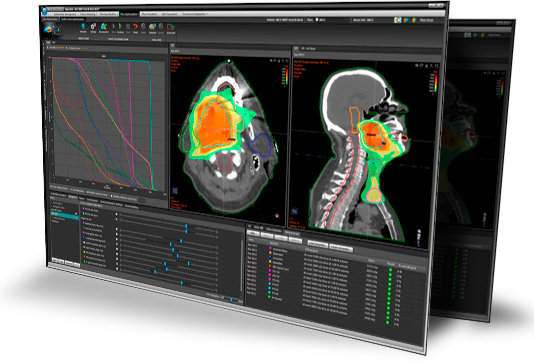
RaySearch Laboratories AB has received 510(k) clearance from the FDA for version 4.5 of its treatment planning system RayStation.
The new version includes a wide range of new features that will help cancer centers improve their treatment planning process and also enable them to take adaptive planning a step further. For example RayStation 4.5 offers ultrafast and robust optimization for proton and photon treatments, boosted dose calculation, automated breast planning and biomechanical deformable registration using the unique MORFEUS technology.
The ultrafast multi-purpose optimization engine in RayStation, rayOptimizer, can solve virtually any posed optimization problem within radiation therapy using all degrees of freedom of the treatment unit.
In the 4.5 version, the robust algorithm can take density and patient setup uncertainties into account. This gives the clinicians a structured tool to handle safety margins more efficiently in the planning process which has the potential to further increase the plan quality.
RayStation’s unrivalled speed of optimization and dose computation has also been improved even further in the new version. The dose calculation algorithms have been rewritten entirely and every step in the process has been optimized to improve computation speed. The new version also includes support for optimization and dose computation using the GPU which lets the user benefit from the latest developments in computer technology as well. Together these improvements lead to extremely fast computation speeds. Optimization and clinical dose computation for a standard prostate IMRT case is done in less than ten seconds and even for a more complex 9-beam IMRT head and neck case on a high resolution 2 mm dose grid, the optimization and dose computation are executed in approximately 30 seconds.
RayStation 4.5 includes a major step forward in the field of automated treatment planning. The new rayAutoBreast module provides tools for automated generation of tangential breast IMRT plans using heuristic optimization and includes features such as:
- Automatic detection of radio-opaque markers defining the breast
- Automatic contouring of all the relevant target and risk organs
- Automatic setup of beams, including heuristic optimization of gantry and collimator angles
- Automatic creation of objective functions, optimization and segmentation settings and clinical goals
rayAutoBreast was initially developed at the Princess Margaret Hospital (PMH) in Toronto, Canada. Between 2009 and 2012, PMH ran a large-scale clinical study to evaluate the performance of their automated treatment planning methodology for tangential breast intensity modulated radiation therapy (IMRT). Automated planning was used for 97 percent of the patients receiving tangential breast IMRT during the time interval studied i.e. in 1661 patients. The study results showed an increase in clinical acceptance using this fully automated method. PMH concluded that the method can add tremendous efficiency, standardization, and quality to the current treatment planning process and that its use will allow faster adoption of IMRT together with increased access to care improvements for breast cancer patients.
RaySearch and PMH also collaborate in adaptive radiation therapy and a new feature in RayStation 4.5 is the MORFEUS technology initially developed by PMH. The unique MORFEUS technology contains a set of algorithms for deformable image registration based on biomechanical modeling of anatomical structures. This makes it possible to track how the radiation dose is delivered to the patient taking into account changes occurring in the patient’s anatomy over the course of treatment. This information can be used to further refine the treatment which has the potential to increase tumor control as well as reduce the risk for side effects. The development and extensive validation of MORFEUS has been documented in several publications in renowned scientific journals.
This know-how is now incorporated in RayStation and enables cancer centers to take adaptive planning a step further. The advanced biomechanical modeling in MORFEUS incorporates not only the material properties of various anatomical structures, but also how they interact and affect each other. Examples include the sliding interface between the lung and the chest, and structural impact of bronchial tree in the lungs.
“RayStation 4.5 is a big step forward in our quest to provide a tool that lets the clinicians focus all their skill and experience on evaluating and refining plan quality. The number of menial repetitive tasks is minimized with our tools for automated planning, and in this release we have achieved game-changing computation speed that I think will revolutionize the whole treatment planning work process. As the computation time is measured in seconds rather than minutes, the user can efficiently create and refine the treatment plans in one sweep instead of opening a second case or going on a break during computations. This is a huge improvement for the clinics that I believe ultimately will lead to better treatment plans as the clinicians will be able to test more options to further tweak the treatments for higher quality”, said Johan Löf, CEO of RaySearch.


 December 11, 2025
December 11, 2025 









